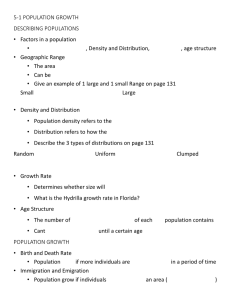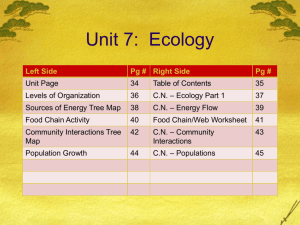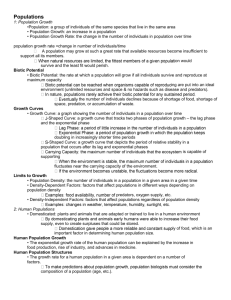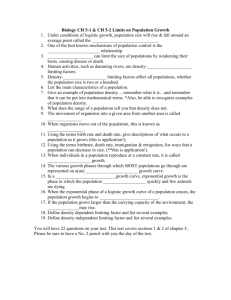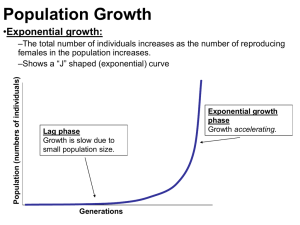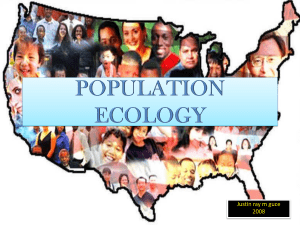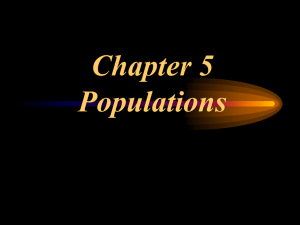Population Growth Curves
advertisement
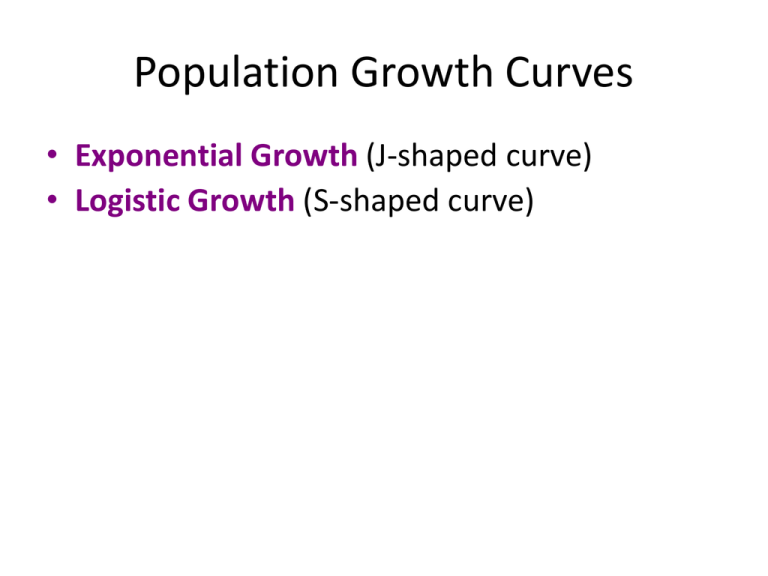
Population Growth Curves • Exponential Growth (J-shaped curve) • Logistic Growth (S-shaped curve) Population ecology • Population ecology is the study of populations. • Population = group of individuals of the same species occupying a common geographical area • Habitat = where a species normally lives • Density = The number of individuals in a population per unit area. Exponential Growth • Indicated by a J-shaped growth curve • growth in which the population increase in a period is a fixed percentage of the size of the population at the beginning of the period; • the number of individuals increases over time logarithmically (e.g. bacterial cultures). Components of an exponential growth pattern for a given population 1. Time Zero - time of establishment of a population; for bacterial culture, time that the culture was inoculated 2. Lag Phase - time that it takes for the population to start growing; resources must be obtained; habitat and microhabitat establishment; niche definition; population prepares for reproduction (for bacterial cultures: time that the cells need to begin their specific type of metabolism before cell division can occur). 3. Log Phase - period of exponential (logarithmic) growth. 4. Stationary Phase - period following exponential growth where number of deaths equals the number of new individuals. 5. Death Phase - period following the stationary phase where the population is dying due to depletion of resources and or contamination of habitat with waste products. STATIONARY PHASE DEATH PHASE EXPONENTIAL/ LOG PHASE LAG PHASE LABEL THE PHASES OF EXPONENTIAL GROWTH Logistic growth (S-shaped curve) • Because of limiting factors, populations rarely exhibit Jshaped growth curves. • When growth encounters environmental resistance, populations experience an S-shaped or logistic growth curve. • Early on populations will exhibit very rapid growth, but as they near the carrying capacity they will level off. • Logistic growth is density dependent. • High density and overcrowding put individuals at greater risk of being killed – Predators, parasites and pathogens have greater numbers of prey and hosts in a smaller area to interact with Components of a Logistic Growth Curve • • • • Lag Phase Log/ Exponential Growth Phase Deceleration Phase Stable, Equilibrium Phase Growth curve of a laboratory population of yeast cells. STABLE EQUILIBRIUM PHASE DECELERATION PHASE EXPONENTIAL/ LOG PHASE LAG PHASE Growth curve of the sheep population of Southern Australia. The smooth curve is the hypothetical logistic curve about which the real curve seems to fluctuate. Effects of population density on growth in open systems: • Density-independent growth - size of population is not a factor in determining the resulting population size overall; – population size, however, stays about the same as when it began. • Most density-independent factors are abiotic. • Examples: temperature, storms, floods, drought, habitat destruction Effects of population density on growth in open systems: • Density dependent growth - size of the population is a factor in determining the resulting population size overall; • exponential growth can occur if adequate resources are available and range expansion can occur as in an open system. • Disease is spread more quickly • Stress can lead to aggression Population growth Populations grow, shrink, or remain stable, depending on rates of birth, death, immigration, and emigration. (birth rate + immigration rate) – (death rate + emigration rate) = population growth rate Exponential growth •Unregulated populations increase by exponential growth: •Growth by a fixed percentage, rather than a fixed amount. •Similar to growth of money in a savings account Exponential growth in a growth curve •Population growth curves show change in population size over time. •Scots pine shows exponential growth Figure 5.10 Limits on growth •Limiting factors restrain exponential population growth, slowing the growth rate down. •Population growth levels off at a carrying capacity— the maximum population size of a given species an environment can sustain. •Initial exponential growth, slowing, and stabilizing at carrying capacity is shown by a logistic growth curve. Logistic growth curve Figure 5.11 Population growth: Logistic growth •Logistic growth (shown here in yeast from the lab) is only one type of growth curve, however. Figure 5.12a Population growth: Oscillations •Some populations fluctuate continually above and below carrying capacity, as with this mite. Figure 5.12b Population growth: Dampening oscillations •In some populations, oscillations dampen, as population size settles toward carrying capacity, as with this beetle. Figure 5.12c Population growth: Crashes •Some populations that rise too fast and deplete resources may then crash, as with reindeer on St. Paul Island. Figure 5.12d

